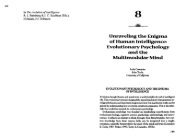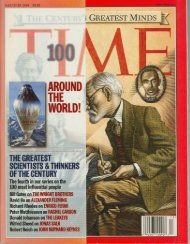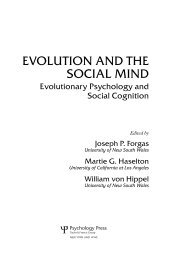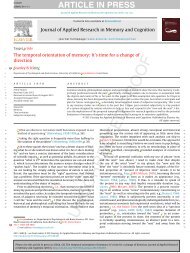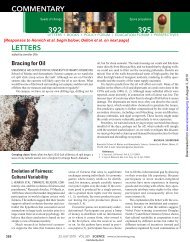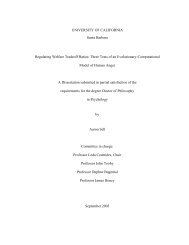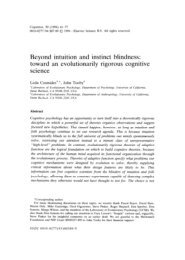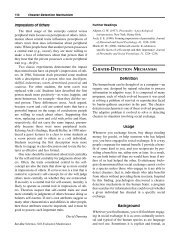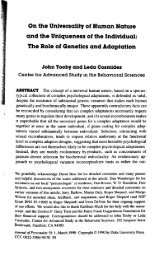Chapter 7 Discussion and Conclusions 7.1 The social contract ...
Chapter 7 Discussion and Conclusions 7.1 The social contract ...
Chapter 7 Discussion and Conclusions 7.1 The social contract ...
Create successful ePaper yourself
Turn your PDF publications into a flip-book with our unique Google optimized e-Paper software.
<strong>Chapter</strong> 7<br />
<strong>Discussion</strong> <strong>and</strong> <strong>Conclusions</strong><br />
<strong>7.1</strong> <strong>The</strong> <strong>social</strong> <strong>contract</strong> hypothesis uniquely accounts for<br />
empirical results on the Wason selection task<br />
Present in any novel situation are an infinite number of<br />
properties <strong>and</strong> relations. Darwinian algorithms are learning<br />
mechanisms keyed to focus attention on those dimensions of a<br />
situation that are evolutionarily important, <strong>and</strong> operate on them<br />
with in£ erential procedures that embody an appropriate<br />
evolutionary strategy. Without Darwinian algorithms, nothing<br />
could be learned; experience could not be structured to guide<br />
action along adaptive paths.<br />
This thesis has proposed the existence of <strong>social</strong> <strong>contract</strong><br />
algorithms. <strong>The</strong>se focus attention on the actions of individuals,<br />
discern what those actions mean in terms of their desires, <strong>and</strong><br />
calculate whether the cost/benefit structure of those desires<br />
indicates that the situation is one of <strong>social</strong> exchange; if it is,<br />
they operate on the cost/benefit structure of the situation with<br />
inference procedures that define cheating <strong>and</strong> facilitate the<br />
detection of cheaters. <strong>The</strong>y operate in novel situations, as well<br />
as familiar ones, guiding inference <strong>and</strong> choices along adaptive<br />
pathways. <strong>The</strong> hypothesis that humans have <strong>social</strong> contact<br />
algorithms was tested using the Wason selection task, a test of<br />
how humans reason.<br />
It was already known that how humans reason on the Wason<br />
selection task varies with what they are reasoning about; the<br />
question was, can the <strong>social</strong> <strong>contract</strong> hypothesis explain much of
that variation? <strong>The</strong> null hypothesis from the st<strong>and</strong>point of the<br />
existing literature is that availability is the sole determinant<br />
of performance on Wason selection tasks of varying content. This<br />
was tested against the hypothesis that humans have <strong>social</strong><br />
<strong>contract</strong> algorithms that are the major determinant of performance<br />
on Wason selection taskg whose content involves <strong>social</strong> exchange.*<br />
Six critical tests -- comparisons for which <strong>social</strong> <strong>contract</strong><br />
theory <strong>and</strong> availability theory make radically different<br />
predictions -- were made by comparing performance on unfamiliar<br />
<strong>social</strong> <strong>contract</strong> problems with performance on both unfamiliar <strong>and</strong><br />
familiar descriptive problems. Availability predicts a low<br />
percentage of logically falsifying, P & not-Q' , responses for<br />
all unfamiliar rules, whether they are <strong>social</strong> <strong>contract</strong>s or not,<br />
<strong>and</strong> does not predict the response 'not-P & Qt under any<br />
circumstance.<br />
Social <strong>contract</strong> theory predicts a high percentage<br />
of 'P & not-Qt responses to "st<strong>and</strong>ard" <strong>social</strong> <strong>contract</strong>s, <strong>and</strong> a<br />
high percentage of 'not-P & Q' responses to "switched" <strong>social</strong><br />
<strong>contract</strong>s -- no matter how unfamiliar the <strong>social</strong> <strong>contract</strong>s are.<br />
<strong>The</strong> critical tests were designed to unambiguously choose between<br />
the <strong>social</strong> <strong>contract</strong> hypothesis <strong>and</strong> the availability hypothesis.<br />
If <strong>social</strong> <strong>contract</strong> algorithms exist, they should produce a highly<br />
distinctive <strong>and</strong> unusual patter n of results .<br />
For all six tests, the <strong>social</strong> <strong>contract</strong> hypothesis was<br />
verified <strong>and</strong> the null hypothesis that availability is the sole<br />
determinant of responses was falsified.<br />
Each of these six tests<br />
was replicated, using different unfamiliar <strong>social</strong> <strong>contract</strong><br />
* <strong>The</strong> <strong>social</strong> <strong>contract</strong> hypothesis is silent on whether<br />
availability exerts an indepedent effect on familiar problems<br />
that do not involve <strong>social</strong> exchange.
problems.<br />
<strong>The</strong> six critical tests, <strong>and</strong> subsequent experiments,<br />
established the following points:<br />
1. Unfamiliar stan- <strong>social</strong> <strong>contract</strong>s elicit the predicted SC<br />
response, 'P & not-Q1, in the vast majority of subjects.<br />
2. Unfamiliar switched <strong>social</strong> <strong>contract</strong>s elicit the predicted SC<br />
response, 'not-P & Q', in the vast majority of subjects.<br />
3. <strong>The</strong> percentage of SC responses elicited by st<strong>and</strong>ard <strong>and</strong><br />
switched <strong>social</strong> <strong>contract</strong>s is equivalent, even though these<br />
responses are quite distinct from a logical point of view ( 'P<br />
& not-Q' versus 'not-P & Q') . This is just what one would<br />
expect if the same algorithm were producing both responses.<br />
4. Social <strong>contract</strong> algorithms ignore for a switched <strong>social</strong><br />
<strong>contract</strong> the cards they should choose for a st<strong>and</strong>ard one, <strong>and</strong><br />
vice versa, just as <strong>social</strong> <strong>contract</strong> theory predicts.<br />
5. Social <strong>contract</strong> algorithms operate just as well in novel<br />
situations as they do in familiar ones: <strong>The</strong> percentage of SC<br />
. .<br />
responses elicited by unfamlLlar <strong>social</strong> <strong>contract</strong>s is<br />
. .<br />
<strong>social</strong> <strong>contract</strong>s.<br />
equivalent to that elicited by famlllar.<br />
6. Social <strong>contract</strong> algorithms are the major determinant of<br />
responses to problems whose content involves <strong>social</strong> exchange.<br />
. .<br />
More SC responses are elicited by unfamlllar <strong>social</strong> <strong>contract</strong>s<br />
than falsifying responses by famlllar<br />
. .<br />
descriptive problems.<br />
<strong>The</strong> <strong>social</strong> <strong>contract</strong> effect is about 50% larger than the<br />
effect availability has on familiar descriptive problems.<br />
7. <strong>The</strong> <strong>social</strong> <strong>contract</strong> effect is replicable with a variety of<br />
familiar <strong>and</strong> unfamiliar <strong>social</strong> <strong>contract</strong>s.<br />
<strong>The</strong> hypothesis that humans have <strong>social</strong> <strong>contract</strong> algorithms
uniquely accounts for the results of these experiments.<br />
It<br />
predicts them <strong>and</strong> it explains them; no other hypothesis proposed<br />
so far can do either.<br />
Moreover, the apparently contradictory<br />
literature attempting to stalk the "elusive" content effect on<br />
the Wason selection task can be systematically explained only by<br />
the <strong>social</strong> <strong>contract</strong> hywhesis. * Robust <strong>and</strong> replicabl e content<br />
effects are found only for rules that are st<strong>and</strong>ard <strong>social</strong><br />
<strong>contract</strong>s: the only rules for which the predicted SC response is<br />
also the logically falsifying response. **<br />
7.2 Are <strong>social</strong> <strong>contract</strong> algorithms innate?<br />
<strong>The</strong>oretical considerations<br />
Availability theories presume the existence of innate<br />
learning mechanisms that are general purpose <strong>and</strong> content-<br />
independent.<br />
However, no variant of availability theory can<br />
adequately explain the results of the experiments presented in<br />
<strong>Chapter</strong> 6.<br />
It is difficult to see how the association 'cassava<br />
root-no tattoo' or 'eats duiker meat-has never found ostrich<br />
eggshell' could have been "cued" from long-term memory (Manktelow<br />
& Evans, 1979; Griggs & Cox, 1982), let alone be the dominant<br />
association for over 70% of undergraduates tested (Pollard,<br />
1982). No matter how wildly unfamiliar the rule's terms, <strong>social</strong><br />
<strong>contract</strong> problems elicited <strong>social</strong> <strong>contract</strong> responses.<br />
Furthermore, if associations between specific terms were<br />
responsible for the pattern of results on <strong>social</strong> <strong>contract</strong> rules,<br />
* Problems with other proposed hypotheses are discussed in depth<br />
in <strong>Chapter</strong> 3.<br />
** See <strong>Chapter</strong> 2 for a detailed review (especially p. 70-71).
then descriptive rules using the same unfamiliar terms should<br />
have elicited the same pattern; they did not.<br />
No theory whose<br />
predictive <strong>and</strong> explanatory power rests on associations between<br />
specific terms used in a <strong>social</strong> <strong>contract</strong> rule can explain the<br />
results of my experiments.<br />
Availability theories that emphasize the role of mental<br />
modeling (Johnson-Laird, 1982) or frames (Wason, 1983; Rumelhart<br />
& Norman, 1981) in recognizing logical contradiction cannot<br />
explain the following aspects of the results:<br />
1. Why would subjects find an unfamiliar <strong>social</strong> <strong>contract</strong><br />
scenario (U-STD-SC) so much easier to model than an<br />
unfamiliar descriptive scenario (U-D) , or indeed, a familiar<br />
one (F-D)?<br />
2. Why would this situation reverse itself on switched <strong>social</strong><br />
<strong>contract</strong>s (U-SWC-SC) , for which the scenario to be modeled is<br />
identical to that for the U-STD-SC? Unlike the U-STD-SC, the<br />
U-SWC-SC does not elicit logically falsifying responses --<br />
although it does elicit the correct <strong>social</strong> <strong>contract</strong> response.<br />
<strong>The</strong> only response an availability theorist of the modeling<br />
variety could make would be to claim that people have a<br />
<strong>social</strong> <strong>contract</strong> "f ramen that recognizes <strong>and</strong> operates<br />
on the cost/benefit structure of a <strong>social</strong> <strong>contract</strong> as presented<br />
in Figure 6.1 (with which I agree -- see <strong>Chapter</strong> 51, but that it<br />
was acquired exclusively through "experiencen -- more precisely,<br />
through experience structured solely by the content-independent ,<br />
general purpose information processing systems presumed by<br />
associationists (Fodor, 1983).<br />
Innateness per se is not the
issue here: Every psychological theory -- even Hume's<br />
associationism -- assumes the existence of innate algorithms that<br />
structure experience. <strong>The</strong> issue is: Are some of the innate<br />
algorithms special purpose, content-dependent, Darwinian algorithms?<br />
<strong>The</strong>re is nothing in availability theory that would lead one<br />
to predict the existence of generalized <strong>social</strong> <strong>contract</strong> frames.<br />
Besides being post-hoc, this view cannot cope with a variety of<br />
fundamental issues, for example:<br />
1. <strong>The</strong>re is no reason to believe that SC rules are more common<br />
than non-SC prescriptive rules (bureaucratic rules, work<br />
orders from employers, safety rules, traffic rules, etc.) or<br />
the ubiquitous descriptive relations people use to describe<br />
<strong>and</strong> act on the world. Why, then, would general purpose<br />
algorithms have produced generalized SC frames, but not<br />
generalized frames for reliably detecting violations of<br />
descriptive or prescriptive* rules?<br />
2. Compliance with <strong>social</strong> <strong>contract</strong>s is far more common than<br />
cheating.<br />
Every time a store lets you walk out with the<br />
goods you have paid for, you have experienced compliance.<br />
General purpose learning mechanisms should therefore create<br />
frames that look for compliance, not cheating. ** At best, a<br />
* A number of non-SC prescriptive rules have been tested, both in<br />
this thesis <strong>and</strong> in the literature: the AP immigration rule of<br />
Experiment 5; the AP of Experiments 1-4, 6; DIAndrade's AP; non-<br />
SC post-office rules in Golding, 1981 <strong>and</strong> Griggs & Cox, 1982; the<br />
apparel-color problem of Cox & Griggs, 1982; the deformed SC<br />
rules of Griggs & Cox, 1983 (see <strong>Chapter</strong> 2).<br />
** Contextual exhortations to "look for cheaters" cannot explain<br />
this. Each non-SC problem contained several similar requests to<br />
see if the facts violate the rule, yet most subjects behaved like<br />
verif icationists, nevertheless.
subject's ratio of compliance-to-cheating episodes should be<br />
the idiosyncratic product of different life experiences, <strong>and</strong><br />
unfamiliar <strong>social</strong> <strong>contract</strong> problems should show at least as<br />
much response variability as familiar descriptive ones.<br />
3. Trial <strong>and</strong> error learning requires some definition of error;<br />
hypothesis testing requires some definition of violation.<br />
A<br />
general purpose, content-independent learning mechanism needs<br />
a general purpose, content-independent definition of error.<br />
Logical falsification, for example, is a content-independent<br />
definition of error or violation. But the definition of<br />
violation for <strong>social</strong> <strong>contract</strong>s is quite specific: Cheating is<br />
defined as absconding with a benefit when you have not paid<br />
the required cost.<br />
It conforms to no known content-<br />
independent definition of error; it certainly does not map<br />
onto logical falsification, as a consideration of switched<br />
<strong>social</strong> <strong>contract</strong>s shows. Without built-in, domain specific<br />
knowledge defining what counts as cheating, how could one<br />
develop a generalized <strong>social</strong> <strong>contract</strong> frame?*<br />
An evolutionarily-based <strong>social</strong> <strong>contract</strong> theory h<strong>and</strong>les<br />
issues like these with ease. Social <strong>contract</strong> theory not only<br />
provides the most parsimonious explanation of the data, but the<br />
assumption that some innate algorithms are special purpose <strong>and</strong><br />
content-dependent is also more parsimonious from the st<strong>and</strong>point<br />
of evolutionary theory.<br />
Social exchange is a domain for which<br />
* It is not sufficient to say that people learn what counts as<br />
cheating because they feel irritated when they have been cheated<br />
<strong>and</strong> therefore attend to the irritating stimuli; that presumes<br />
they already know what constitutes cheating. Having been cheated<br />
was the stimulus that triggered the irritation in the first place.
the evolutionarily-predicted computational theory is complex, <strong>and</strong><br />
the fitness costs associated with "errors" are large.<br />
Even if it<br />
were possible for a domain general in£ ormation processing<br />
strategy to construct <strong>social</strong> <strong>contract</strong> algorithms -- <strong>and</strong> it is by<br />
no means clear that it<br />
possible -- it is not reasonable to<br />
expect that natural selection would leave learning in such a<br />
domain to a general purpose mechanism.<br />
Successfully conducted<br />
<strong>social</strong> exchange was such an important <strong>and</strong> recurrent feature of<br />
hominid evolution, that a reliable, efficient cognitive capacity<br />
specialized for reasoning about <strong>social</strong> exchange would quickly be<br />
selected for.<br />
A general purpose learning mechanism would either<br />
be supplanted or used only for learning in other domains.<br />
Ontogeny<br />
Evolutionary considerations can also guide research into the<br />
ontogeny of the <strong>social</strong> <strong>contract</strong> algorithms (see Cosmides, 1980) .<br />
<strong>The</strong> brain is a metabolically expensive organ ; expensive cognitive<br />
capacities should not mature until the organism needs them, so<br />
that metabolic energy can be devoted to other kinds of growth.*<br />
Social <strong>contract</strong> algorithms are not useful to a child until its<br />
welfare depends on individuals whose fitness interests are not<br />
identical to its own -- individuals to whom it must offer a<br />
benefit to get a benefit.<br />
Until weaning, the interests of mother<br />
<strong>and</strong> child are identical; benefiting the infant benefits the<br />
mother equally.<br />
Weaning marks the beginning of the end of this<br />
coincidence of interest.<br />
It is a period of intense parent-<br />
* Spurts in brain growth appear to be correlated with spurts in<br />
cognitive development (Epstein, 1974a, b) .<br />
263
off spring conflict in both humans* <strong>and</strong> other primates (Trivers,<br />
1976; Shostak, 1981), a period when the child wants more<br />
investment than the parent, who is ready to invest in a new<br />
offspring, is willing to give.<br />
After being weaned from the<br />
breast, the child is weaned from its mother's side; its welfare<br />
depends increasingly on the behavior of the less related<br />
individuals with whom it is left. At this point, the ability to<br />
cajole, threaten, exchange, <strong>and</strong> negotiate become crucial.<br />
Thus, evolutionary considerations suggest that the learning<br />
mechanisms that under lie the ability to engage in <strong>social</strong> exchange<br />
should begin to mature slightly before the age usually associated<br />
with the onset of weaning during most of human evolution.<br />
World-<br />
wide, the average age of weaning is age two (Whiting, personal<br />
communication**), <strong>and</strong> this figure agrees well with life history<br />
estimates from the San, the hunter-gatherer group whose way of<br />
life is currently believed to most resemble that of Pleistocene<br />
hunter-gatherer s.<br />
A mechanism that guides learning about <strong>social</strong> exchange<br />
should include features that allow the child to a) model other<br />
people' s values, both by noting their emotional reactions <strong>and</strong><br />
attempting to manipulate their behavior, b) categorize values<br />
according to who has them, c) be aware of its own abilities, as<br />
these determine what the child is capable of offering to others,<br />
* Most markedly in cultures where the only other food sources<br />
are difficult for infants to digest; for example, weaning among<br />
the San, who eat a high proportion of fibrous bush food as<br />
adults, appears to be particularly stressf ul (e. g., Shostak, 1981) .<br />
** This figure agrees with data for a population believed to<br />
approximate natural fertility conditions (Bongaarts & Potter,<br />
1983, pp. 25, 90 , 145) .
d) under st<strong>and</strong> <strong>and</strong> apply concepts of obligation <strong>and</strong> entitlement,<br />
e) become interested in notions of fairness <strong>and</strong> cheating, f)<br />
practice intercontingent behavior, g) remember its history of<br />
exchange with other individuals (see <strong>Chapter</strong> 5) .<br />
Intriguingly, Kagan (1981) has collected cross-cultural data<br />
suggesting the maturation, just prior to age two, of a cognitive<br />
capacity that looks suspiciously like it is specialized for<br />
learning about <strong>and</strong> engaging in <strong>social</strong> exchange.<br />
According to<br />
Kagan, the mental organ that emerges at this age includes:<br />
* the concept of obligation,<br />
* interest in <strong>and</strong> concern with other people's values,<br />
* the ability to underst<strong>and</strong> when an emotional reaction is<br />
"appropriate" to a person's age <strong>and</strong> situation,<br />
* an awareness of one's own capacities for action,<br />
* the ability to under st<strong>and</strong> other people's intentions <strong>and</strong><br />
anticipate their actions,<br />
* an interest in trying to coax others into doing what the child<br />
wants (per haps the most distinguishing characteristic of the<br />
"terrible twos").<br />
Moreover, it is at about this age that language, the ultimate<br />
negotiative tool, begins to emerge.<br />
<strong>The</strong> computational theory of<br />
<strong>social</strong> exchange presented in <strong>Chapter</strong> 5 should allow one to<br />
generate predictions about other capacities that can be expected<br />
to co-occur with those already discovered (see Cosmides, 1980) .<br />
<strong>The</strong> finding that adult subjects are very adept at detecting<br />
potential "cheaters" on a <strong>social</strong> <strong>contract</strong>, even when it is<br />
unfamiliar <strong>and</strong> culturally alien, st<strong>and</strong>s in marked contrast to the<br />
repeated finding that they are not skilled at detecting the<br />
26 5
potential invalidity of descriptive rules, familiar or<br />
unfamiliar.<br />
<strong>The</strong> ontogeny of the algorithms that produce these<br />
results remains an open question. It is possible that they are,<br />
in some carefully delimited sense, learned. However, the mental<br />
processes involved appear to be power£ ully structured for <strong>social</strong><br />
<strong>contract</strong>s, yet weakly structured for other elements <strong>and</strong> relations<br />
drawn from common experience. This iifplies that the learning<br />
process involved is guided <strong>and</strong> structured by special purpose<br />
innate algorithms, just as learning a natural language is guided<br />
<strong>and</strong> structured by the innate algorithms of the language<br />
acquisition device.<br />
7.3 <strong>The</strong> role of evolutionary theory in psychology<br />
For the past 100 years, domain general psychological<br />
mechanisms have been the Holy Grail of experimental psychology.<br />
Paradigms rose <strong>and</strong> fell, mentalism gave way to behaviorism gave<br />
way to mentalism, but, undaunted, the quest for an equipotential<br />
psyche continued.<br />
And psychology, after a century of research, is not yet an<br />
integrated science.<br />
<strong>The</strong>re may be a connection between these two facts. It may<br />
be that the processes that govern attention, perception, memory,<br />
categorization, reasoning, <strong>and</strong> learning simply are not<br />
equipotential. <strong>The</strong> Grail of legend could not be found because it<br />
did not exist.<br />
<strong>The</strong> human mind did not evolve to attend "in general", to<br />
remember "in general," to learn "in general". It evolved to<br />
attend _tp predators, _tp the needs of kin, fn potential sexual<br />
266
partners, agents of threat. <strong>The</strong> cognitive processes required<br />
for different evolutionarily important domains are different in<br />
kind: Attention to predators requires a high level of false<br />
positives to cues indicating felids <strong>and</strong> snakes; attention to the<br />
needs of kin requires selective orientation to emotion cues<br />
emitted by relatives, <strong>and</strong> the mobilization of reasoning <strong>and</strong><br />
investigational processes that allow one to infer what it is that<br />
they need.<br />
Attention, perception, categorization, learning, memory,<br />
decision making, <strong>and</strong> reasoning cannot be studied in isolation<br />
from motivation, emotion, behavior, <strong>and</strong> <strong>social</strong> psychology.<br />
To do<br />
so is to carve the study of psychology into artificial units that<br />
will not hang together.<br />
All these aspects of human psychology<br />
must be mobilized in different ways to solve different adaptive<br />
problems. As <strong>Chapter</strong> 5 illustrated, cognition, motivation,<br />
emotion, <strong>and</strong> behavior all must play specific <strong>and</strong> well-defined<br />
roles in solving the various adaptive problems associated with<br />
<strong>social</strong> exchange.<br />
<strong>The</strong> search for domain specific Darwinian algorithms promises<br />
to integrate psychology, precisely because it focuses on adaptive<br />
problems. Cognitive psychologists can begin addressing issues<br />
closer to the heart of human nature. <strong>The</strong> study of emotion <strong>and</strong><br />
motivation can be welcomed back into psychological theory, as<br />
systems for mobilizing the appropriate Darwinian algorithms when<br />
the situation "calls f orn them. <strong>The</strong> exile of behavior from<br />
cognitive theory can end, because the presumed purpose of<br />
adaptive thought is to produce adaptive behavior.<br />
Psychology <strong>and</strong> evolutionary biology are sister disciplines.<br />
267
<strong>The</strong> goal of evolutionary theory is to define the adaptive<br />
problems that organisms must be able to solve.<br />
<strong>The</strong> goal of<br />
psychological theory is to discover the information processing<br />
mechanisms that have evolved to solve them.<br />
Alone, each is<br />
incomplete for the under st<strong>and</strong>ing of human nature.<br />
Together, they<br />
are powerful: as I hope the research presented in this thesis<br />
demonstrates, under st<strong>and</strong>ing what adaptive problems the human mind<br />
was designed to solve is a great aid to discovering how it works.<br />
An evolutionary psychology would proceed adaptive problem by<br />
adaptive problem, domain by domain.<br />
Many adaptive problems have<br />
already been defined by evolutionary biologists. <strong>The</strong> real<br />
challenge for psychologists is to develop experimental methods<br />
that will allow the outlines of the psychological mechanisms that<br />
solve these problems to be traced.<br />
Happily, cognitive<br />
psychologists are in an excellent position to do this, having<br />
already invented an impressive array of concepts <strong>and</strong> experimental<br />
methods for tracking complex in£ ormation processing systems.<br />
<strong>The</strong><br />
experiments reported in <strong>Chapter</strong> 6 are a first attempt at such an<br />
approach: they used an experimental paradigm that had already<br />
been developed by cognitive psychologists.<br />
<strong>The</strong> hypothesis that the human mind is a equiptential<br />
information processing system has been entertained for one<br />
hundred years. It is time for a change. <strong>The</strong> human mind is not a<br />
machine that fell out of the sky, of unknown purpose.<br />
<strong>The</strong> human<br />
mind was designed by natural selection to accomplish specific,<br />
well-defined adaptive functions.<br />
An equipotential psyche cannot<br />
accomplish these functions.<br />
A cognitive science that ignores<br />
this reality is a cognitive science that will fail.<br />
26 8
Appendix A:<br />
<strong>The</strong> Frame Problem <strong>and</strong> So-Called "Constraintsn on Learning<br />
Biologists <strong>and</strong> psychologi sts have a mysterious tendency to<br />
refer to the properties of domain specific (but not domain<br />
general) mechanisms as "constraints. " For example, the one-trial<br />
learning mechanism, discovered by Garcia & Koelling (1966), that<br />
permits a blue jay to associate a food taste with vomiting<br />
several hours later, is frequently refered to as a "biological<br />
constraint on learning". Books reporting the existence of domain<br />
specific learning mechanisms frequently have titles like:<br />
"Biological Boundaries of Learning" (Seligman & Hager, 1972) or<br />
"<strong>The</strong> Tangled Wing: Biological Constraints on the Human Spiri tl'<br />
(Konner , 1982) . This terminology is dangerously misleading,<br />
because it incorrectly implies that "unconstrained" learning<br />
mechanisms are a theoretical possibility.<br />
All constraints are properties, but not all proper ties are<br />
constraints. Calling a property a "constraint" implies that the<br />
organism would have a wider range of abilities if the constraint<br />
were to be removed.<br />
Are a bird's wings a "constraint on locomotion"? Birds can<br />
locomote by flying or hopping. Wings are a property of birds<br />
that enables them to locomote by flying, but wings are not a<br />
"constraint on locomotion." Wings exp<strong>and</strong> the bird1s capacity to<br />
locomote -- with wings, the bird can fly U hop.<br />
Removing a<br />
bird1s wings reduces its capacity to locomote -- without wings,<br />
it can hop, but not fly. Wings cannot be a constraint, because<br />
removing them does not give the bird a wider range of locomoting<br />
abilities. If anything, wings should be called "enablers",<br />
269
ecause they enable an additional form of locomotion.<br />
them actually exp<strong>and</strong>s the bird's capacity to locomote. *<br />
Having<br />
A thick rubber b<strong>and</strong> placed such that it pins a bird's wings<br />
to its body is a constraint on the bird's ability to locomote:<br />
With the rubber b<strong>and</strong> the bird can only hop; without it the bird<br />
can both hop <strong>and</strong> fly.<br />
Similarly, there is no evidence that the domain specific<br />
mechanisms that permit one trial learning of an association<br />
between a taste <strong>and</strong> vomiting are "constraints on learning."<br />
Removing the specific properties that allow the efficient<br />
learning of this particular association, would not exp<strong>and</strong> the<br />
bird's capacity to learn, it would reduce it. Not only would the<br />
blue jay be unable to associate an electric shock with vomiting,<br />
it would also be unable to associate a food taste with vomiting.<br />
Having wings to fly is, however, a constraint on (or more<br />
precisely, a restricted subset of) the Ue0retica.l class of all<br />
possible means of locomotion.<br />
A robin is capable of only two<br />
members of this theoretical set -- it cannot crawl, trot, roll,<br />
swim, burrow, or travel through time warps <strong>and</strong> worm holes in space --<br />
it can only hop <strong>and</strong> fly . Having wings i s not, however, a<br />
~onstraint pn khe m s m ' s &&lJ&y & -ate. Similarly,<br />
internal representations of the movements of solid objects appear<br />
to be "constrained" by the same laws of kinematic geometry that<br />
* <strong>The</strong> ability to fly may turn out to place constraints on an<br />
alternative kind of locomotion, that is, efficient bipedal<br />
locomotion (flying requires hollow bones, which may not be strong<br />
enough to permit prolonged walking or hopping) U j& Fs naf a<br />
~onstraint pn khe birds capacitv & locomote. Furthermore:<br />
Whether the ability to fly places constraints on the efficiency<br />
of bipedal locomotion is an m i r i m claim: One cannot simply<br />
assume, a priori, that having the ability to locomote by one<br />
means reduces the efficiency of another kind of locomotion.
govern the movement real objects: we only imagine a subset of the<br />
theoretically infinite number of possible paths by which an<br />
object can travel between two points (Shepard, 1984). This<br />
subset is the same subset true of real objects. However, domain<br />
specific knowledge like this exp<strong>and</strong>s the our capacity to<br />
accurately model the world, it does not reduce it.<br />
This mysterious tendency is perhaps the result of the<br />
mistaken notion that a tabula rasa is possible, that learning is<br />
possible in the absence of a great deal of domain specific innate<br />
knowledge. If true, then a property that "preparesn an organism<br />
to associate vomiting with a taste may preclude it from<br />
associating an electric shock with that taste.<br />
However, if an<br />
organism had a domain general associative mechanism, there is no<br />
reason why that mechanism should not work to pair taste with<br />
electric shocks. One would have to hypothesize that the presence<br />
of food somehow shut off the domain general mechanism -- <strong>and</strong> this<br />
is an empirical claim that would have to be demonstrated.
Appendix B: Natural Selection in Action<br />
How many generations will it take for indiscriminate altruists<br />
to go extinct?<br />
(see <strong>Chapter</strong> 5, p. 138)<br />
Imagine a population with n "altruists" (individuals who always<br />
cooperate, regardless of whether they are playing another altruist or<br />
a cheater) <strong>and</strong> n "cheaters" (individuals who never cooperate), where n<br />
is a very large number.* Fag simplicity's sake, assume each<br />
individual reproduces asexually, produces 2 offspring in the absence<br />
of any exchange, then dies. Each individual plays one Prisoner's<br />
Dilemma game per generation, <strong>and</strong> this game 'bff ects the number of<br />
offspring produced according to the payoff matrix in Figure 7.2 (+1 =<br />
one more of fspring, for a total of 3; -1 = one less than, for a total<br />
of 1, <strong>and</strong> so on). Whether a particular individual plays with an<br />
altruist (A) or cheater (C) is r<strong>and</strong>om, <strong>and</strong> therefore proportional to<br />
the percentage of the population which each represents. P (A) =<br />
probability'of playing with an altruist <strong>and</strong> P(C) = probability of<br />
playing with a cheater.<br />
Expected reproductive value<br />
for an individual altruist = [5 x P(A)] + [O x P(C)]<br />
Expected reproductive value<br />
for an individual cheater = [7 x P(A)] + [2 x P(C)]<br />
Absolute numbers<br />
Per cent of Population<br />
A C<br />
Parental<br />
generation n n<br />
When n = 10, the altruists are extinct after the fifth generation (F5).<br />
When 10 < n < 2857, the altruists would be extinct after the sixth<br />
generation (F6) .<br />
* This assumption simply smooths out the probabilities. For example,<br />
if n=10, then P(A plays with C) = .53, P(A plays with A) = .47, P(C<br />
plays with A) = .53, P(C plays with C) = .47. As n reaches infinity,<br />
all four probabilities converge on .5. Using the exact probabilities<br />
for a small n, simply drives altruists to extinction a bit faster.
Appendix Cs<br />
PAGE 5<br />
You are a homicide detective for the Boston Police. For months,<br />
you have been gathering evidence against the infamous Owens<br />
Brothers. Jake <strong>and</strong> Ted Owens are in the drug trade, <strong>and</strong> are<br />
responsible for sever a1 particularly bloody underworld murders.<br />
<strong>The</strong>y are shrewd <strong>and</strong> tricky -- they have eluded capture for<br />
months. You have amassed a huge amount of evidence against them<br />
- your testimony in court could send them to jail for life. <strong>The</strong><br />
problem is, they know it - <strong>The</strong>y have made several attempts on<br />
your life. <strong>The</strong>y are ruthless killers <strong>and</strong> they want you dead.<br />
An anonymous phone caller tells you that Ted will be down at the<br />
docks at 10 tonight. You go down there -- the docks are<br />
deserted. You turn a corner, <strong>and</strong> there is Ted. Quickly you pull<br />
your gun, shouting 'Preezel*. Just as Ted is putting his h<strong>and</strong>s<br />
in the air, you feel a gun in your back <strong>and</strong> hear Jake's cold<br />
voice behind you, saying:<br />
'If you make one false move, I'll kill you.'<br />
What should you do? Does he mean it? <strong>The</strong> cards below have<br />
information about how this story could end. Each card represents<br />
an ending - not necessarily different endings. One side of a<br />
card tells whether you gave up your gun, <strong>and</strong> the other side of<br />
the card tells whether Jake Owens shot you.<br />
Indicate only those card(s) you definitely need to turn over to<br />
nee if Jake has broken his 'promisem in any of these endings.<br />
.................<br />
A. :<br />
: Jake shoots :<br />
: YOU :<br />
s .:<br />
.................<br />
C. : :<br />
: Jake lets :<br />
: you go :<br />
:...............:<br />
.................<br />
8. : :<br />
: You give them :<br />
: your gun :<br />
I...............:<br />
.................<br />
D- : :<br />
: You shoot :<br />
Ted<br />
z...............:<br />
Threat Problems<br />
PAGE 5<br />
You are a narcotics detective for the Cambridge Police. For<br />
months, you have been gathering evidence against Professor Owens<br />
<strong>and</strong> his student Bill. Professor Ovens is a mild mannered fellow<br />
who is interested in the consciousness-exp<strong>and</strong>ing potential of<br />
hallucidatory drugs -- but he has had trouble getting his<br />
research funded. Be <strong>and</strong> his students have been using University<br />
chemistry labr to manufacture LSD to re11 on campus, in order to<br />
fund their research. You have enough evidence to arrest them --<br />
the problem is, you have not been able to find them.<br />
An anonymous phone caller tells you that the student, Bill, will<br />
be down at the docks at 10 tbnight. You go down there -- the<br />
docks are deserted. You turn a corner, <strong>and</strong> there is Bill.<br />
Quickly you pull your gun, shouting 'Freezelm. Just as Bill is<br />
putting his h<strong>and</strong>s in,the air, you feel a gun in your back <strong>and</strong><br />
hear Professor Owens voice behind you, saying:<br />
'If you make one false move, I'll kill you.*<br />
What should you do? Docs he mean it? <strong>The</strong> carda below have<br />
information about how this story could end. Ea-ch card represents<br />
an ending - not necessarily different endings. One side of a<br />
card tells whether you gave up your gun, <strong>and</strong> the other side of<br />
the card tells whether Professor Owens shot you.<br />
Indicate only those card(s) you definitely need to turn over to<br />
see if Profesror Owens ha8 broken his mpromisem in any of these<br />
endings.<br />
.................<br />
A. : I<br />
: Owens shoots r<br />
: YOU :<br />
.................<br />
C. : I<br />
: Ovens lets r<br />
: you go :<br />
.................<br />
B. r :<br />
r You give them :<br />
: your gun :<br />
I...............:<br />
.................<br />
D. : :<br />
: You shoot :<br />
: Bill :<br />
I...............:
BIBLIOGRAPHY<br />
Personal communications :<br />
David Pi1 beam<br />
Department of Anthropology<br />
Harvard Univer sity<br />
John Whiting<br />
Department of Anthropology<br />
Harvard University<br />
Peter Wason E.O. Wilson<br />
Department of Phoneti'Es & Linguistics Department of Biology<br />
Univer si ty Coll ege London<br />
Harvard University<br />
Axelrod, R. evolution nf -. New York: Basic<br />
Books, 1984.<br />
Axelrod, R. & Hamilton, W.D. <strong>The</strong> evolution of cooperation.<br />
Science, 1981, U, 1390-1396.<br />
Bahrick, H.P., Bahrick, P.O., & Wittlinger, R.P. Fifty years of<br />
memory for names <strong>and</strong> faces: a cross-sectional approach.<br />
Journal nf =ental psvcholoav t Gene&, 1975, JU, 54-75.<br />
Bartlett, F.C. Ranem- A fitudv in gx~erimenral mil <strong>social</strong> .<br />
-. Cambridge, UK: Cambridge University Press, 1932.<br />
. . .<br />
Boden, M. BrtlfiU intelliaence natural m. New York:<br />
Basic Books, 1977.<br />
Bongaarts, J. & Potter, R.G.<br />
New York: Academic Press, 1983.<br />
Bowlby, J. Attachment<br />
Books, 1969.<br />
. .<br />
Fertilitv, Uloav, mdBehavior.<br />
loss (Volume 1). New York: Basic<br />
Bracewell, R.J. & Hidi, S.E. <strong>The</strong> solution of an inferential<br />
problem as a function of the stimulus materials.<br />
Journal pf ExDerimental PSVC~O~O~, 1974, 26, 480-488.<br />
Brown, C., Keats, J.A., Keats, D.M., & Seggie, I. Reasoning<br />
about implication: A comparison of Malaysian <strong>and</strong> Australian<br />
subjects. Journal gf Ooss - Cultural P ? , , 1980, U, 395-<br />
410.<br />
Bruner, J.S. Beyd information aivgn. (J.M. Anglin, ed.)<br />
New York: Norton & Co., 1973.<br />
Bruner, J.S. search af; mind; Fssavs autobioarawhy. New<br />
York: Harper k Row, 1984.<br />
. .<br />
Bruner, J.S., Goodnow, J.J. & Austin, G.A. studv kiunbmg.<br />
New York: Wiley, 1956.<br />
. .<br />
<strong>and</strong> Psvcholoay, in press.<br />
Buss, D. Sex differences in human mate selection criteria: An<br />
evolutionary perspective. In Sociobioloav
Carey, S. & Diamond, R. Maturational determination of the<br />
developmental course of face encoding. In D. Caplan (ed.) ,<br />
Bioloaical studies af mental processa. Cambridge, MA: <strong>The</strong> MIT<br />
Press, 1980.<br />
Chomsky, N. Reflectim m -. New York: R<strong>and</strong>om House, 1975.<br />
Clark, H.H.! & Clark, E.V. P+$!~bgy iUd Bn<br />
roduction k~ psvcholingylstics. New York: Harcourt, 1977.<br />
Cosmides, L. Adaptation <strong>and</strong> negotiation: A developmental<br />
approach. Unpublished manuscript, Harvard University, 1980.<br />
Cosmides, L.<br />
Invariances in the acoustic expression of emotion<br />
during speech. J91~.& Qf F-mental Psvcholoav t Human<br />
P- <strong>and</strong> performance, 1983, 9, 864-881.<br />
Cox, J.R., & Griggs, R.A. <strong>The</strong> effects of experience on<br />
performance in Wason's selection task. &mxy l<strong>and</strong> -, . .<br />
1982, J&, 496-502.<br />
Cutting, J.E., Proffitt, D.R., & Kozlowski, L.T. A biomechanical<br />
invariant for gait perception. 6- Pf ExgeLimental<br />
Psvcholoav L Hymaq per ce~tion a d Performance, 1978, 4, 357-37 2.<br />
Dawkins, R. mended m e .<br />
Freeman, 1982.<br />
. .<br />
de Waal, F. SUmpimzee gollt~a<br />
Powe~<br />
York: Harper & Row, 1982.<br />
San Francisco: W.H.<br />
<strong>and</strong> aumg a.gmii. New<br />
Eibl-Eibesfeldt, I. Ftholoav: <strong>The</strong> bioloav Pf Behavior (second<br />
edition). New York: Holt, Rinehart <strong>and</strong> Winston, Inc., 1975.<br />
Ekman, P. motion buman face (second edition).<br />
Cambridge, UK : Cambridge University Press, 1982.<br />
Epstein, H.T. Phrenoblysis: Special brain <strong>and</strong> mind growth<br />
periods . I : Human brain <strong>and</strong> skull development. Developmental<br />
Psvchobioloav 2, 1974 (a) , 207-216.<br />
Epstein, H.T. Phrenoblysis: Special brain <strong>and</strong> mind growth<br />
periods. I1 : Human mental development. D-W<br />
psvch~ioloav 1, 1974 (b), 217-224.<br />
Evans, J.St.B.T., &<br />
. .<br />
Lynch, J.S. Matching bias in the selection<br />
task. British Journal nf Psvcholoav, 1973, 64, 391-397.<br />
Fillenbaum, S. Inducements: On the phrasing <strong>and</strong> logic of<br />
conditional promises, threats, <strong>and</strong> warnings. psvchologi~<br />
Wearc,h, 1976, u, 231-250.<br />
Fodor, J.A. <strong>The</strong> hmgsge pf thouaht. Cambridge, MA: Harvard<br />
University Press, 1975.
Fodor, J.A. Wodularitv pf mind. Cambridge, MA: <strong>The</strong> MIT Press, 1983.<br />
Garcia, J. & Koelling, R.A. Relations of cue to consequence in<br />
avoidance learning. Psvchonomic Mence, 1966, A, 123 -124.<br />
Gardner, N. attered mind. New York: R<strong>and</strong>om House, 1974.<br />
Gilhooly, K.J. & Falconer, W.A. Concrete <strong>and</strong> abstract terms <strong>and</strong><br />
relations in testing a rule. Quart- J o u m Pf -entd<br />
Psvcholoav, 1974, 26, 355-359.<br />
Gleitman, L.R. & Wanner, E. Language acquisition: <strong>The</strong> state of<br />
the state of the art. In E. Wanne,r & L.R.<br />
. * .<br />
Gleitman (eds.) ,<br />
Lanauaae acaulsltl- state nf khs ~JA. Cambridge, UK:<br />
Cambridge University Press, 1982.<br />
Golding, E. <strong>The</strong> effect of past experience on problem solving.<br />
Paper presented at the Annual Conference of the British<br />
Psychological Society, Surrey Univer sity , April, 1981.<br />
Goodall, J. van Lawick-<br />
<strong>The</strong> behaviour of free-living chimpanzees<br />
in the Gombe Stream Reserve. Animal Behaviour Monoar@ I, 1968.<br />
Goodall, J. van Lawick- J& shadow nf W. Boston: Houghton-<br />
Mif flin, 1971.<br />
Goodwin, R.Q. & Wason, P.C. Degrees of insight. Brit-<br />
Qf Psvcholoav, 1972, 63, 205-212.<br />
. . lzQuad.<br />
Grice, H.P. Meaning. Philosophj&alReview, 1957, 66, 377-388.<br />
Grice, H.P. Logic <strong>and</strong> conversation. Unpublished William James<br />
Lectures, Harvard University, 1967.<br />
Griggs, R.A.<br />
<strong>The</strong> role of problem content in the selection task<br />
<strong>and</strong> in the THOG problem. In J. St.B.T. Evans, (Ed.) , . .<br />
<strong>and</strong> r e a s o m Psvcholoaical Uoroaches . London : Rout=<br />
Kegan Paul, 1983.<br />
. .<br />
Griggs, R.A., & Cox, J.R. <strong>The</strong> elusive thematic-materials effect<br />
in-wason's selection task. Fritm Qf P-r 1982,<br />
l3, 407-420.<br />
Griggs, R.A. & Cox, J.R. <strong>The</strong> effects of problem content <strong>and</strong><br />
negation on Wason's selection task. w t e r l y Journal pf<br />
Ex~erimental Psvcholoqy, 1983, m, 519-533.<br />
Hall, K., & DeVore, I. Baboon <strong>social</strong> behavior. In I. DeVore<br />
(ed.) , W mate beha-. New York: Hol t, 1965.<br />
Hamilton, W.D. <strong>The</strong> genetical evolution of <strong>social</strong> behaviour.<br />
Journal ad <strong>The</strong>oretical, Bioloav, 1964, L, 1-52.<br />
Hamilton, W.D.<br />
A1 tr uism <strong>and</strong> related phenomena, mainly in <strong>social</strong><br />
insects. Annual Beview Pf F- <strong>and</strong> Svstemiatics, 1972, 3,<br />
193-232.
Heisenberg, W. Phvsics bevond. New York: Harper & Row, 1971.<br />
Herrnstein, R. J. <strong>The</strong> evolution of behaviorism.<br />
psvcholo~, 1977, 3.2, 593-603.<br />
American<br />
Hughes, M.A.M. <strong>The</strong> use of negative information in concept<br />
attainment. (Doctoral dissertation, University of London, 1966.<br />
Hume, D. An enauiry concern- human derstzmding. (E.<br />
Steinberg, ed. ) Indianapolis: Hackett , 1977.<br />
Hrdy, S. Blaff er . woman that never. evolvd. Cambridge, !A:<br />
Harvard Univeri sty Press, 1981.<br />
& Piaget, J. Growu pf loaicd. thlnklna. . .<br />
Inhelder, B.<br />
*From<br />
dhood i 3 . 1 . New York: Basic Books, 1958.<br />
. . , 1978, 258, 90-108.<br />
Issac, G.Ll. <strong>The</strong> food-sharing behavior of protohuman hominids.<br />
Sdent lflc Broeri can<br />
Janis, I., & Frick, F. <strong>The</strong> relationship between attitudes toward<br />
conclusions <strong>and</strong> errors in judging logical validity of<br />
-<br />
syllogisms. Jourm ef &&&ximental P-, 1943, a,<br />
73-77.<br />
Johnson-Laird, P.N. Thinking as a skill. Ouarterlv Journal pf<br />
RxD~~ imental Psvchol ouv , 1982, 3PB, 1-29.<br />
Johnson-Laird, P.N. j4ental W Towards n<br />
Pf lanauaae. inference. <strong>and</strong> ~nsciousness. CEdge, MA:<br />
Harvard University Press, 1983.<br />
Johnson-Laird, P.N., Legrenzi, P. & Sonino Legrenzi, M.<br />
Reasoning <strong>and</strong> a sense of reality. British Journalpf<br />
PSVC~O~O~, 1972, 0, 395-400.<br />
Johnson-Laird, P.N. & Wason, P. Insight into a logical relation.<br />
Ouarterlv Journal ef -Y, 1970, 2.2, 49-61.<br />
Jolly, A. llhe evolution Q£ r>rimate behavior. New York:<br />
Macmillan, 1972.<br />
. .<br />
Kagan, J. ThS: ernvi-uwux Qf self awareness<br />
Harvard University Press, 1981.<br />
- . Cambridge, MA:<br />
Kant, I.<br />
. .<br />
Pf pure xeason. New York: Anchor Books, 1966.<br />
Kinzey, W.G. m a t e models fnr oriain af human b a .<br />
New York: SUNY Press, 1985.<br />
W tanaled wins: Biological constraints nn kl.u,t human<br />
Konner, M.<br />
i t . New York: Holt, Rinehart, & Winston, 1982.<br />
Kozlowski, L.T., & Cutting, J.E. Recognizing the sex of a walker<br />
from a dynamic point-light display. perc- &<br />
, 1977, 2, 575-580.
. . . London:<br />
Popper, K.R. J&gj.~ pf scientlflc disxuay<br />
Hutchinson, 1959.<br />
Popper, K.R. Objective knowledae. An evolulimuY aa2==h.<br />
London: Oxf ord University Press, 1972.<br />
Quine, W.V.O.<br />
1950.<br />
Methods pf Loaic. (Third Edition) New York: Holt,<br />
. .<br />
Quine, W.V.O. Qntoloaical relativitv <strong>and</strong> QJ&LK essays. New<br />
York: Columbia University Press, 1969.<br />
. .<br />
Journal Qt P e w ,<br />
Reich, S.S. & Ruth, P. Wason's selection task: Verification,<br />
falsification <strong>and</strong> matching, Brltlsh<br />
1982, D, 395-405.<br />
Roberge, J. J. Linguistic <strong>and</strong> psychometric factors in<br />
p~opositional reasoning. m-<br />
Psvcholoqy, 1978, 2, 705-716.<br />
Roberge, J.J.<br />
Journal pf ExDerimental<br />
Linguistic factors in conditional reasoning.<br />
Quarterlv Journal Pf ExDerimental l%ydmU&gy, 1982 , ;L4, 275-284.<br />
Rosenthal, R. & Rosnow, R.L. Essentials pf b- research:<br />
Bethods data -. New Yor k: McGraw-Hill, 1984.<br />
. .<br />
. , . skills<strong>and</strong>their<br />
Rumelhart, D. E., & Norman, D.A. Analogical processes in<br />
learning. In J.R. Anderson (Ed.) , Coautlve<br />
dcau~tioq. Hillsdale, NJ: Erlbaum, 1981,<br />
Schank, R. & Abelson, R. P. Scr i~ts*<br />
under st&- . Hillsdale, NJ: Erlbaum, 1977.<br />
aoals. iuul<br />
Searle, J.R. (Ed.) &iJoso~hv pf hnguag~ Oxford: Oxford<br />
University Press, 1971.<br />
Seligman, M.E.P. & Hager, J.L. Biological bound- pf<br />
-. New York: Meredith, 1972.<br />
Shepard, R. N, Ecological constraints on internal representation:<br />
Resonant kinematics of perceiving, imagining, thinking, <strong>and</strong><br />
dreaming. psvcholoaic~ Review, 1984, fir 417 -447.<br />
Shepard, R.N. Evolution of a mesh between principles of the mind<br />
<strong>and</strong> regularities of the world. Paper presented at the<br />
Conference on Evolution <strong>and</strong> Information, Stanford University,<br />
April, 1985.<br />
Shepher, J. Ucest t A biosocW view.<br />
1983.<br />
New York: Academic Press,<br />
Shostak, M. Nisa: life <strong>and</strong> words pf a woman,<br />
Cambridge, MA : Harvard University Press, 1981.
Smuts, B. Special relationships between adult male <strong>and</strong> female<br />
olive baboons (w m) . Doctoral dissertation, Stanford<br />
University, 1982.<br />
Sokal, R.R., & Rohlf, F.J. m. San Francisco: Freeman, 1969.<br />
Strum, S.C. Baboons may be smarter than people. Animal Khgba,<br />
1985, 88, 12-25.<br />
Tooby, J. Prospects for an evolutionary psychology. Unpublished<br />
manuscript, Harvard' University, 1975.<br />
Tooby, J. Pathogens, polymorphism wd the evolution of sex.<br />
Jourm nf <strong>The</strong>oretical w, 1982, ql, 557-576.<br />
Tooby, J. <strong>The</strong> emergence of evolutionary psychology. In D. Pines<br />
(ed. ) , Emeraina mheses b e n c e . New Mexico: Rio Gr<strong>and</strong>e<br />
Institute, in press.<br />
Tooby, J. & DeVore, I. <strong>The</strong> reconstruction of hominid behavioral<br />
evolution through strategic modeling. In W.G. Kinzey (ed.),<br />
primate models fpr khe oriain nf human behavior. New York: SUNY<br />
Press, 1985.<br />
Trivers, R.L. <strong>The</strong> evolution of reciprocal altruism. Quckdy<br />
Rev- ~ Bioloay, 1971, 46, 35-57.<br />
Trivers, R.L. Parent-off spring conflict. American Booloaist,<br />
1974, 19, 249-264.<br />
. .<br />
P S V C ~ O ~ O ~ ,<br />
Tversky, A. & Kahneman, D. Availability: A heuristic for judging<br />
frequency <strong>and</strong> probability. Coanitive<br />
1973, 5, 207-<br />
232.<br />
Van Duyne, P. C. Realism <strong>and</strong> linguistic complexity in reasoning.<br />
Journal pf psv~h010~v, 1974, 65, 59-67.<br />
Van Duyne, P.C. Necessity <strong>and</strong> contingency in reasoning.<br />
choloaicg, 1976, a, 85-101.<br />
Ward, P., & Zahavi, A. <strong>The</strong> importance of certain assemblages of<br />
birds as ' information-centres' for food finding. Ibis, 1973,<br />
l.J.5, 517-534.<br />
Wason, P.C. Reasoning. 1nB.M. Foss (Ed.),WUizomh<br />
Psvcholoav. Harmondsworth: Penguin, 1966.<br />
Wason, P.C. Reasoning about a rule. Quarterlv Journal pf<br />
Experimental gsvcholoqy, 1968, 24, 273-281.<br />
Wason, P. C. Structural simp1 ici ty <strong>and</strong> psycho1 ogi cal compl exi ty :<br />
Some thoughts on a novel problem. Bulletin pf BritFSh<br />
Psvcholoaic~ Society, 1969, 22, 281-284. (a)<br />
Wason, P.C.<br />
Psvcholo~, 1969, dQ, 471-480.<br />
Regression in reasoning? BritFSh Journal af<br />
(b)



